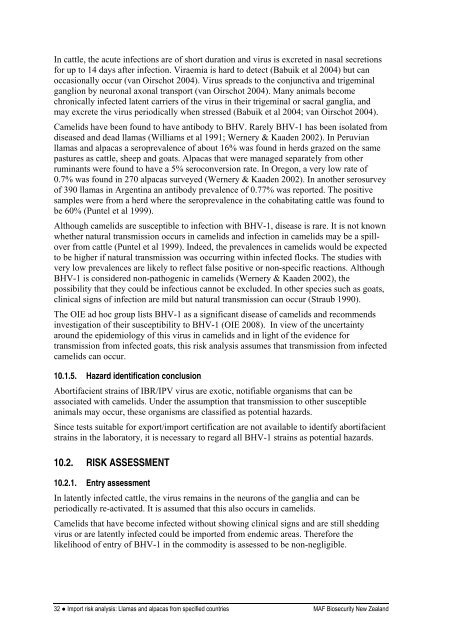Import risk analysis: Llamas (Lama glama) and alpacas (Vicugna ...
Import risk analysis: Llamas (Lama glama) and alpacas (Vicugna ...
Import risk analysis: Llamas (Lama glama) and alpacas (Vicugna ...
You also want an ePaper? Increase the reach of your titles
YUMPU automatically turns print PDFs into web optimized ePapers that Google loves.
In cattle, the acute infections are of short duration <strong>and</strong> virus is excreted in nasal secretions<br />
for up to 14 days after infection. Viraemia is hard to detect (Babuik et al 2004) but can<br />
occasionally occur (van Oirschot 2004). Virus spreads to the conjunctiva <strong>and</strong> trigeminal<br />
ganglion by neuronal axonal transport (van Oirschot 2004). Many animals become<br />
chronically infected latent carriers of the virus in their trigeminal or sacral ganglia, <strong>and</strong><br />
may excrete the virus periodically when stressed (Babuik et al 2004; van Oirschot 2004).<br />
Camelids have been found to have antibody to BHV. Rarely BHV-1 has been isolated from<br />
diseased <strong>and</strong> dead llamas (Williams et al 1991; Wernery & Kaaden 2002). In Peruvian<br />
llamas <strong>and</strong> <strong>alpacas</strong> a seroprevalence of about 16% was found in herds grazed on the same<br />
pastures as cattle, sheep <strong>and</strong> goats. Alpacas that were managed separately from other<br />
ruminants were found to have a 5% seroconversion rate. In Oregon, a very low rate of<br />
0.7% was found in 270 <strong>alpacas</strong> surveyed (Wernery & Kaaden 2002). In another serosurvey<br />
of 390 llamas in Argentina an antibody prevalence of 0.77% was reported. The positive<br />
samples were from a herd where the seroprevalence in the cohabitating cattle was found to<br />
be 60% (Puntel et al 1999).<br />
Although camelids are susceptible to infection with BHV-1, disease is rare. It is not known<br />
whether natural transmission occurs in camelids <strong>and</strong> infection in camelids may be a spillover<br />
from cattle (Puntel et al 1999). Indeed, the prevalences in camelids would be expected<br />
to be higher if natural transmission was occurring within infected flocks. The studies with<br />
very low prevalences are likely to reflect false positive or non-specific reactions. Although<br />
BHV-1 is considered non-pathogenic in camelids (Wernery & Kaaden 2002), the<br />
possibility that they could be infectious cannot be excluded. In other species such as goats,<br />
clinical signs of infection are mild but natural transmission can occur (Straub 1990).<br />
The OIE ad hoc group lists BHV-1 as a significant disease of camelids <strong>and</strong> recommends<br />
investigation of their susceptibility to BHV-1 (OIE 2008). In view of the uncertainty<br />
around the epidemiology of this virus in camelids <strong>and</strong> in light of the evidence for<br />
transmission from infected goats, this <strong>risk</strong> <strong>analysis</strong> assumes that transmission from infected<br />
camelids can occur.<br />
10.1.5. Hazard identification conclusion<br />
Abortifacient strains of IBR/IPV virus are exotic, notifiable organisms that can be<br />
associated with camelids. Under the assumption that transmission to other susceptible<br />
animals may occur, these organisms are classified as potential hazards.<br />
Since tests suitable for export/import certification are not available to identify abortifacient<br />
strains in the laboratory, it is necessary to regard all BHV-1 strains as potential hazards.<br />
10.2. RISK ASSESSMENT<br />
10.2.1. Entry assessment<br />
In latently infected cattle, the virus remains in the neurons of the ganglia <strong>and</strong> can be<br />
periodically re-activated. It is assumed that this also occurs in camelids.<br />
Camelids that have become infected without showing clinical signs <strong>and</strong> are still shedding<br />
virus or are latently infected could be imported from endemic areas. Therefore the<br />
likelihood of entry of BHV-1 in the commodity is assessed to be non-negligible.<br />
32 ● <strong>Import</strong> <strong>risk</strong> <strong>analysis</strong>: <strong>Llamas</strong> <strong>and</strong> <strong>alpacas</strong> from specified countries MAF Biosecurity New Zeal<strong>and</strong>

















